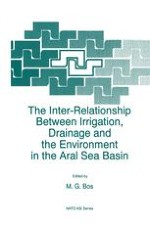1996 | OriginalPaper | Buchkapitel
Drainage Development in the Arid Zones of Central Asia
verfasst von : Victor Dukhovny
Erschienen in: The Inter-Relationship Between Irrigation, Drainage and the Environment in the Aral Sea Basin
Verlag: Springer Netherlands
Enthalten in: Professional Book Archive
Aktivieren Sie unsere intelligente Suche, um passende Fachinhalte oder Patente zu finden.
Wählen Sie Textabschnitte aus um mit Künstlicher Intelligenz passenden Patente zu finden. powered by
Markieren Sie Textabschnitte, um KI-gestützt weitere passende Inhalte zu finden. powered by
Irrigation has been the foundation of agriculture in Central Asia since ancient times. The earliest proof of irrigated agriculture is found in sources dating from the fifth century B.C. The scale and size of the remains of old irrigation systems (canals, dams) are surprising. By the seventh century A.D., the irrigated area in Central Asia was more than 2 million ha, but most of this area had good natural drainage conditions, with groundwater outflow exceeding infiltration and inflow of groundwater. The local population practised irrigation in areas of unsatisfactory natural drainage (deltas, lowlands, alluvial plains). They used the so-called “dry drainage” system, in which cultivated lands occupied no more than 25% of the total irrigable area, and evaporation from the remaining area helped to maintain the groundwater balance. This method was connected with extensive land use in old Horesm, Bactria, and other lowland territories in Central Asia. We find remains of artificial drainage systems (“zaur”, open shallow collectors of 1.5 to 2.5m depth) only in plains immediately next to the foothills, where gravel-and-sand layers covered by clay and loam are susceptible to waterlogging and salinity under the pressure of artesian water.
